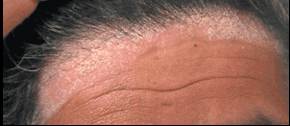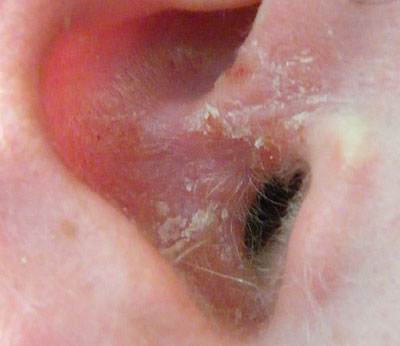Scalp and Ear Psoriasis
SCALP PSORIASIS

Psoriasis that affects the scalp is also called seborrheic psoriasis. Most often, psoriasis appears on the scalp which is a really the common name of 'dandruff'. Patches of psoriasis scales can appear anywhere beyond the scalp itself such as down on the neck, into the ear area and onto the forehead. Psoriasis of the scalp will not cause any harm to the hair follicle. There is no correlation with alopecia (hair loss), but the scales may become hard and thick, which may led to hair thining However, this is not permanent and will grow back again after the psoriasis clears.
This form of psoriasis can be extremely uncomfortable. It is often very itchy, and the psoriatic patches that are inflamed and sore can start to bleed if they are scratched or picked. The condition is not caused by poor hygiene or hair care. Scalp psoriasis can be demoralizing, as the look of dead skin cells on clothing can be embarrassing, and it is not always easy to brush them off inconspicuously. Itchiness is another big problem, not only because of the social implication but also because it inflames the condition and makes it worse. Forehead along the hair line is a common site as is the temples, nape of the neck, around the ears, as well as the hair parting.
Massaging a little warm baby/olive/coconut/jojoba oil gently into the scalp, preferably before going to bed, allow 30 minutes of time to soak (bind up the head in an old towel) will help. Wash hair and scalp with shampoo as you normally would. Only shampoo three times a week, more than this and the natural oils may be washed out. Always treat the head as gently as possible, do not comb or brush harshly. Perms and colorants can be used as long as the skin is not broken. Shampoo the hair and scalp with a tar-based shampoo that can be purchased over-the-counter or by prescription. Shampoos, scalp steroid lotions, vitamin D analogues and some tar preparations such as tar pomade may be used on the scalp.
EAR PSORIASIS

Psoriasis is commonly found in the ears and behind the ears also. In this case it can appear as dry scales in the ear canal. The image shows some dryness of the skin in the ear, with some scaling, which is characteristic of psoriasis. Psoriasis of the ears occurs in approximately 18 percent of all patients at some time.
Psoriasis of the ear canal can be frustrating with the build up of psoriasis scales and ear wax which may result in a reduction of hearing.
The eardrum is easily damaged. It is best to avoid picking and scratching the affected areas of the ear. Careful cleansing of the ear area can be done using over-the-counter ear-cleaning kits that involve squirting small amounts of fluid into the ear and letting it drain. Plain warm water, followed by a thin layer of Jojoba oil applied with a cotton swab, is also effective for some people.
The use of an excellent product for the external ear or internal ear psoriasis would be Psoriasis-Ltd III (link below). The best way of application is after bathing, leave the ear wet and glide the Psoriasis-ltd III disk over the affected area of the external ear. And for the internal ear canal, you may apply the ingredients of Psoriasis-Ltd III to a Q-Tip by rubbing the Q-Tip across the Psoriasis-Ltd III disk. Then gently and carefully twirl the Q-Tip down the ear canal to transfer the ingredients to the affected area. Use extreme care not to touch the eardrum. You will find Psoriasis-Ltd III here for ear psoriasis
